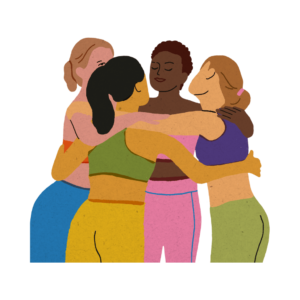In the vast realm of human connections, emotional safety stands as a cornerstone, often determining the depth and quality of our relationships. At its core, emotional safety is the freedom to be oneself — to laugh, cry, share, and even disagree without the looming shadow of ridicule or rejection. It’s the comforting knowledge that our feelings, thoughts, and vulnerabilities will be met with understanding and respect, rather than judgment or harm.
Imagine a world where every word you utter or emotion you display is constantly scrutinized, criticized, or dismissed. Such an environment stifles genuine expression, leading to surface-level interactions devoid of authenticity. On the contrary, when emotional safety is present, it acts as a nurturing soil, allowing relationships to flourish and reach their fullest potential.
This profound sense of emotional safety doesn’t just apply to romantic relationships. It’s equally vital in friendships, familial ties, and even professional settings. When individuals feel emotionally safe, they are more likely to share innovative ideas, express concerns, and collaborate effectively.
In this article, we aim to shed light on the multifaceted concept of emotional safety. We’ll explore its pivotal role in shaping meaningful connections, delve into its various components, and provide actionable insights on how to nurture and maintain it in all types of relationships.
What is Emotional Safety?
Emotional safety is the profound sense of security one feels when one can freely be themselves in a relationship or environment. It’s like a protective shield, allowing individuals to express a range of emotions, from joy to sorrow, without the fear of judgment or misunderstanding.
Imagine standing on a cliff’s edge, ready to dive into the waters below. The cliff symbolizes our vulnerabilities and emotions, while the water represents the world of relationships. Emotional safety assures us that the waters are welcoming, and free from hidden dangers, inviting us to dive in with confidence.
Without this safety, many wear masks, hiding true emotions to fit societal molds. It’s like walking on eggshells, suppressing genuine feelings. But in an emotionally safe environment, trust and openness prevail. Feelings are met with empathy, concerns are voiced without fear, and joy is shared freely.
The Role of Emotional Safety in Vulnerability
Vulnerability is the brave act of revealing one’s deepest emotions and fears. While often seen as a risk, it’s this very openness that deepens human connections. However, for vulnerability to be a strength rather than a liability, the presence of emotional safety is crucial.
Think of emotional safety as a warm embrace when you’re at your most exposed. It assures that your rawest moments will be met with compassion and understanding, not criticism. Without this safety, being vulnerable can feel like navigating a minefield, where every revelation risks pain or judgment. But in a safe environment, vulnerability becomes a bridge to deeper connections.
In all relationships, this interplay between safety and vulnerability is vital. It allows for genuine sharing, understanding, and support. Essentially, emotional safety enables vulnerability, and openness.
Recognizing Emotional Unsafety
In the realm of relationships, detecting emotional unsafety is pivotal. This subtle yet damaging state can undermine trust and genuine connection, making it essential to spot and address its signs promptly.
A clear indicator is the urge to mask one’s true emotions, stemming from the anticipation of negative reactions or misunderstandings. This self-guarding can lead to feelings of isolation and disconnect.
Another sign is the apprehension of facing ridicule or backlash when sharing feelings or concerns. This fear hampers open communication and can result in bottled-up emotions.
Lastly, if one consistently feels their emotions are overlooked or belittled, it’s a sign of emotional unsafety. Such experiences can erode self-worth and confidence.
Being aware of these signs, both in ourselves and in those around us, allows for timely intervention, fostering trust and ensuring everyone feels valued and understood.
Cultivating Emotional Safety
Active Listening
Active listening goes beyond merely processing spoken words; it’s a deep dive into understanding the emotions and intentions behind them. This skill demands full engagement, requiring one to set aside distractions, maintain eye contact, and prioritize the speaker. Simple gestures like nodding, maintaining an open posture, and resisting the urge to interrupt signal genuine interest and respect. Reflecting on what’s been said and offering empathetic responses further emphasize understanding and connection.
In essence, active listening is about offering the invaluable gift of one’s undivided attention. By truly tuning in and providing a space for someone to express themselves, we foster deeper connections and pave the way for more meaningful interactions in our relationships.
Validating Feelings
Validation is a powerful tool in human interactions, serving as a bridge of understanding between individuals. At its core, validation is the recognition and acceptance of another person’s emotions and experiences. It’s not about endorsing or agreeing with their perspective, but rather about seeing and acknowledging their feelings as valid and real. This act of acknowledgment can be transformative, providing comfort and assurance that one’s emotions are heard and understood, even if they aren’t shared.
Using simple, empathetic phrases such as “I understand why you feel that way” or “That sounds tough; I’m here for you” can have a profound impact. These statements convey empathy and show the other person that their feelings matter. In a world where many feel unheard or dismissed, offering validation can be a beacon of support, fostering trust and deepening connections in relationships.
Avoiding Blame and Accusations
“I” statements are a cornerstone of effective communication, especially in situations charged with emotion or potential conflict. By framing sentiments from one’s own perspective, these statements emphasize personal feelings and experiences without casting blame. They shift the focus from pointing fingers to sharing emotions, allowing for a more open and constructive dialogue. When we express ourselves using “I feel” or “I believe,” we invite understanding and empathy, rather than putting the listener on the defensive.
Conversely, “You” statements can often come across as accusatory or critical, even if unintentionally so. Phrases like “You always” or “You never” can make the listener feel attacked, leading to defensiveness and hindering productive conversation. By choosing to express feelings with “I” statements, such as “I feel hurt when…”, we pave the way for healthier, more understanding interactions, fostering an environment where both parties feel heard and respected.
Creating a Judgment-Free Zone
Each individual’s life is a tapestry woven from a myriad of experiences, beliefs, and emotions, all of which shape their unique perspective. Recognizing this diversity of thought and experience is essential in fostering understanding and empathy in interactions. When we pause to consider that another person’s viewpoint is shaped by a set of circumstances entirely different from our own, we begin to appreciate the richness and complexity of human experience. This acknowledgment not only broadens our own horizons but also nurtures mutual respect and understanding.
Immediate judgment can act as a barrier, preventing genuine connection and understanding. By consciously choosing to set aside preconceived notions and making an effort to see the world through another’s eyes, we create a safe space for open dialogue. This approach encourages sharing, reduces defensiveness, and paves the way for deeper, more meaningful connections. In essence, embracing the myriad perspectives around us enriches our own worldview and strengthens the bonds of community and togetherness.
Open Communication
Regular conversations about feelings, concerns, and needs serve as the heartbeat of healthy relationships. By fostering an environment where open dialogue is not only welcomed but encouraged, individuals are given the space to express themselves authentically. Such discussions act as preventive measures, addressing potential issues before they escalate. By understanding and acknowledging each other’s emotions and needs, we pave the way for mutual respect and deeper connections, ensuring that no concern goes unnoticed or unaddressed.
Moreover, this proactive approach to communication plays a pivotal role in building and maintaining trust. When individuals feel heard and understood, it reinforces the belief that they are in a safe and caring environment. Over time, these regular check-ins become the foundation upon which strong, resilient relationships are built, characterized by transparency, understanding, and mutual respect. Through consistent and open communication, we fortify the bonds of trust, ensuring the longevity and health of our relationships.
Setting Boundaries
Boundaries, often misunderstood as walls or limitations, are in fact essential components of healthy relationships. They represent an individual’s understanding of what they are comfortable with, both emotionally and physically, and serve as a roadmap for how they wish to be treated. Establishing boundaries is an act of self-awareness and self-respect, signaling to others one’s limits and preferences. By setting clear boundaries, individuals can navigate relationships with clarity, ensuring that interactions are respectful and aligned with their values and comfort levels.
Openly discussing and mutually respecting these boundaries is crucial for fostering trust and understanding in any relationship. When boundaries are acknowledged and honored, it sends a message of respect and care, reinforcing the idea that each individual’s feelings and needs are valued. Conversely, overstepping or disregarding these boundaries can lead to discomfort and strain. By recognizing and upholding the boundaries set by ourselves and others, we cultivate relationships that are balanced, respectful, and built on a foundation of mutual trust and understanding.
Empathy: Walking in Their Shoes
Empathy, often described as the ability to walk in another’s shoes, is a powerful and transformative emotional skill. It transcends mere sympathy, which is feeling compassion for someone and delves into truly experiencing and understanding their emotions. Empathy bridges the gap between individuals, allowing them to connect on a profound level. When we empathize, we not only acknowledge another’s feelings but also resonate with them, creating a shared emotional experience that fosters genuine understanding and connection.
In the context of relationships, practicing empathy is paramount. By making a conscious effort to see situations from your partner’s viewpoint, you create a space where both of you feel heard and valued. This mutual understanding strengthens the emotional bond, ensuring that even in disagreements, there’s a foundation of respect and care. Over time, consistently showing empathy nurtures trust, deepens intimacy, and solidifies the relationship, making it resilient in the face of challenges.
The Long-Term Benefits of Emotional Safety
Emotionally safe environments act as sanctuaries, where individuals can freely express themselves without the fear of judgment or ridicule. In such spaces, authenticity flourishes, paving the way for deeper and more meaningful connections. When people feel safe, they are more likely to open up, share their vulnerabilities, and truly connect with others on a profound level. This depth of connection goes beyond surface interactions, fostering relationships rooted in genuine understanding and mutual respect.
Furthermore, the benefits of emotionally safe environments extend to one’s mental well-being. When individuals feel valued and accepted, it bolsters their self-esteem and reduces feelings of anxiety or isolation. A sense of belonging emerges, creating a community where trust and cooperation thrive. In such a nurturing atmosphere, individuals not only form strong bonds with others but also experience personal growth, resilience, and a heightened sense of purpose. The ripple effects of emotional safety, therefore, touch every facet of one’s life, from interpersonal relationships to overall mental and emotional health.
Overcoming Challenges to Emotional Safety
Every relationship, regardless of its depth or duration, faces its share of ups and downs. These challenges, whether minor disagreements or significant conflicts, test the strength and resilience of the bond. Prioritizing emotional safety becomes the compass that guides these relationships through stormy waters. By ensuring that both parties feel heard, respected, and valued, even the most challenging conversations can be approached with understanding and empathy. Emphasizing emotional safety transforms potential confrontations into opportunities for growth, understanding, and deeper connection. It shifts the focus from winning an argument to understanding a perspective, leading to resolutions that are mutually beneficial and reinforcing the relationship’s foundation.
Conclusion
Emotional safety, often an overlooked aspect of relationships, stands as a pillar upon which genuine connections and understanding are built. It’s the invisible thread that binds individuals, allowing them to navigate the complexities of human emotions with grace, empathy, and mutual respect. By fostering an environment of trust, active listening, and validation, we pave the way for deeper connections, improved mental well-being, and a strengthened sense of belonging.
As we journey through the intricacies of relationships, it’s essential to remember that the foundation of any lasting bond is the assurance of emotional safety. By prioritizing this, we not only enrich our own relationships but also set a standard for healthy, meaningful interactions in our broader communities. In a world filled with fleeting connections, let’s champion the cause of emotional safety, ensuring that every interaction is rooted in understanding, respect, and genuine care.
References
- Brown, B. (2015). Daring Greatly: How the Courage to Be Vulnerable Transforms the Way We Live, Love, Parent, and Lead. Gotham Books. New York, NY.
- Gottman, J. M., & Silver, N. (1999). The Seven Principles for Making Marriage Work. Harmony. New York, NY.
- Rosenberg, M. B. (2015). Nonviolent Communication: A Language of Life. PuddleDancer Press. Encinitas, CA.
- Tannen, D. (1990). You Just Don’t Understand: Women and Men in Conversation. William Morrow and Company. New York, NY.
- Goleman, D. (2005). Emotional Intelligence: Why It Can Matter More Than IQ. Bantam Books. New York, NY


















